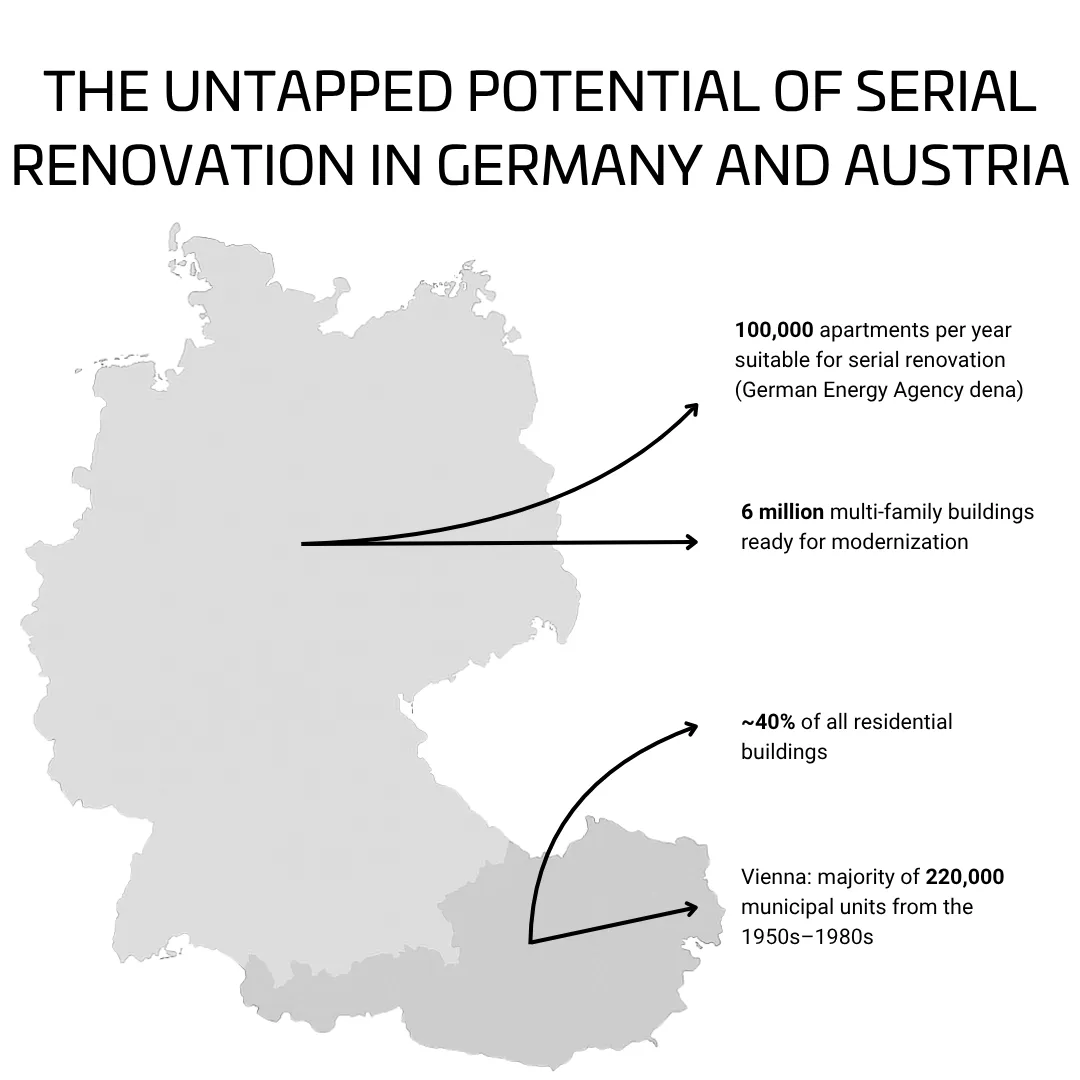When it comes to renovating older buildings, cities like Vienna, Berlin, Munich, Graz, and Linz face a major challenge:
millions of apartments are due for refurbishment and urgently need modernization. One promising approach is serial renovation – but what does it actually mean?
What does serial renovation mean?
In serial renovation, façade and roof elements as well as complete building services modules are prefabricated industrially – not produced on site, but manufactured in controlled factory conditions.
These prefabricated components are then mounted directly onto the existing building like a modular system.
The result: an energy-efficient “envelope” that makes older buildings fit for the future.
The advantages at a glance
Serial renovation offers numerous benefits compared to conventional refurbishment methods:
- Faster construction time: Prefabrication shortens on-site work to just a few weeks.
- Less disturbance for residents: Installation is quick and generates far less noise and dust.
- Consistent quality: Industrial production ensures uniformly high standards.
- Cost reliability: Standardized processes make costs easier to plan and control.
- Reduced construction waste: Precisely prefabricated components minimize debris and packaging waste – conserving resources and lowering disposal costs.
- High potential: Particularly suitable for multi-family buildings from the 1950s to 1980s, which often require urgent modernization.
Why is serial renovation such a relevant topic in Germany and Austria?
Both Germany and Austria have a vast stock of older buildings – many of which were constructed long before today’s energy standards and are now true energy guzzlers.
- Germany: Of the roughly 36 million buildings, around 75–80 % are considered in need of energy-efficient refurbishment.
- Austria: Here, too, over 60 % of the approximately 2.2 million residential buildings are either not modernized or only partially upgraded.
Adding to the urgency is growing regulatory pressure: Under the EU’s Energy Performance of Buildings Directive (EPBD), all new buildings must be emission-free by 2030, and existing buildings must become climate-neutral by 2050 as part of the European Green Deal. Germany aims to achieve climate neutrality by 2045, Austria even earlier – by 2040.
Serial renovation as a key to the climate transition
Precisely because of these challenges, serial renovation offers enormous potential. It enables large-scale, cost-efficient modernization of entire residential districts – a decisive lever for cities and housing associations.
Examples from Germany:
- Around 6 million multi-family buildings are considered suitable for serial renovation.
- According to the German Energy Agency (dena), it is realistic to refurbish 100,000 apartments per year using this approach.
Examples from Austria:
- Estimates suggest that around 40 % of existing residential buildings could benefit from serial renovation – particularly in cities such as Vienna, Linz, and Graz, which have many large post-war housing complexes.
- The MasSan study, led by RENOWAVE.AT, is currently analyzing the potential of serial renovation for large-scale buildings in Austria.
The City of Vienna, for example, owns more than 220,000 municipal apartments, many built between the 1950s and 1980s – making it an ideal testing ground for serial modernization.

INNOVAMETALL: modular products for serial renovation
One company setting new standards in this field is INNOVAMETALL. In addition to being a manufacturer of high-quality products, the company also acts as a general contractor for serial renovation projects – including planning, implementation, and project management. Thanks to the modular design of its products, large numbers of units can be installed in rapid sequence, significantly reducing both time and costs for clients.
Solutions by INNOVAMETALL:
- sybkon balconies: Modular balcony systems that integrate perfectly into serial renovation concepts – precise in fit, time-saving, and architecturally refined.
- SOLAR SKY PARK: An innovative system that transforms any parking area into an e-mobility charging hub – complete with integrated photovoltaic installation.
- safetydock: Intelligent mobility stations with integrated energy management, designed for secure bicycle storage, parcel delivery, and more – ideal for modern urban residential developments.

